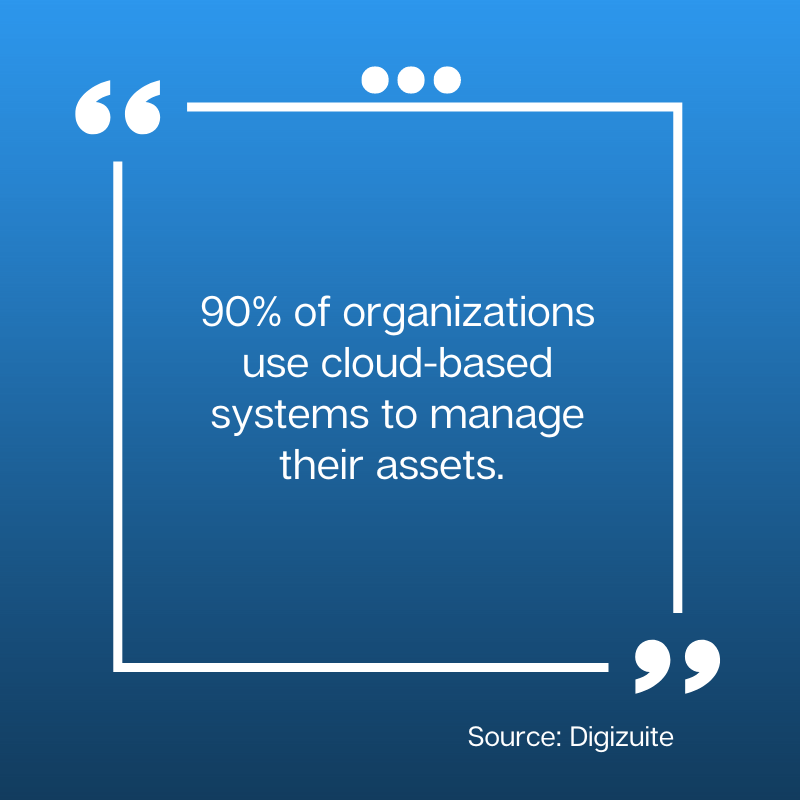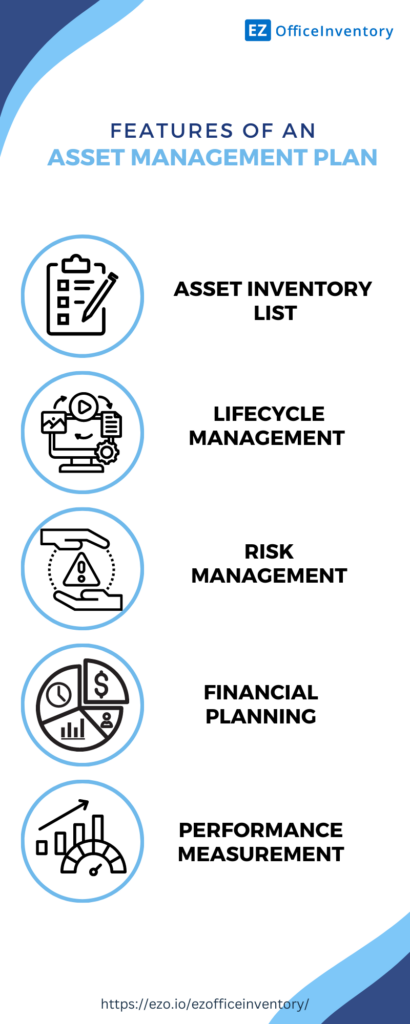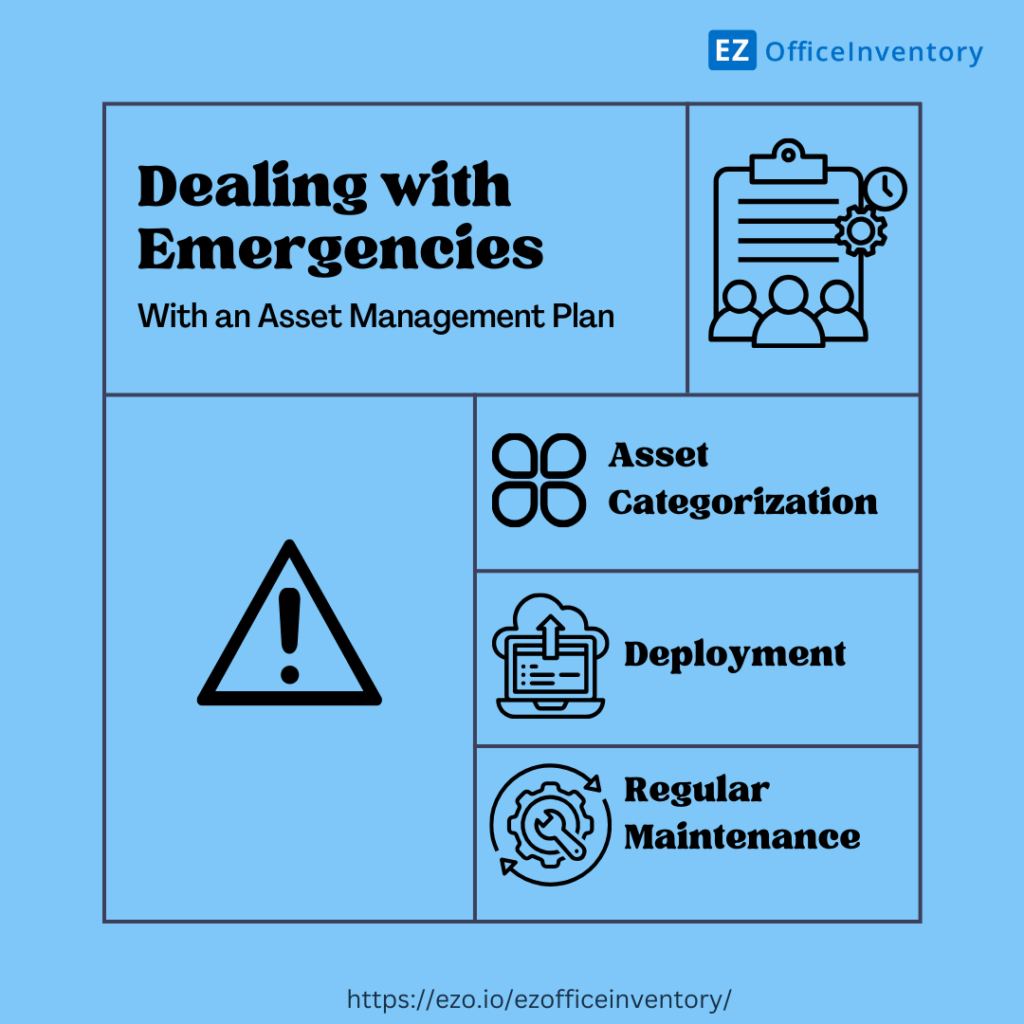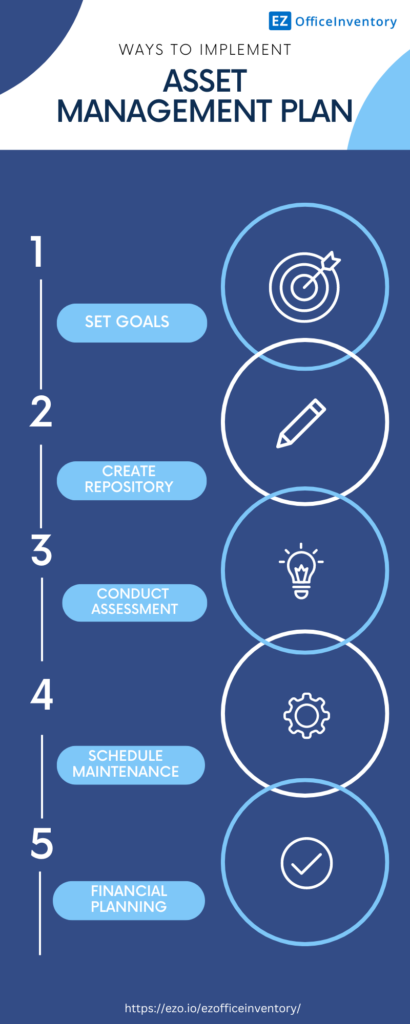


Creating a sound asset management plan is the core of smooth business operations. It provides a blueprint for organizations to achieve excellence in managing assets effortlessly – by defining criteria to handle asset-related emergencies. Businesses usually have a variety of assets to maintain, necessitating a strategic asset-tracking approach. These plans include effectively using assets, improving their lifecycle, and maximizing their utility. Asset management plans can be best achieved when implemented with cloud-based systems. 90% of organizations use cloud-based systems to manage their assets and almost 48% plan on adopting one eventually. This blog takes you through the basics of the asset management plan, and how it can be implemented using an asset management system.
An asset management plan is a structured process outlining how an organization can manage assets throughout their lifecycle. It covers the broader asset infrastructure of your organization and provides an integrated approach to operating and maintaining assets. Asset management plans are used widely by government agencies, healthcare organizations, and construction companies to mitigate risks. The aim is to streamline organizational management efforts while achieving performance goals and establishing asset control. These plans help organizations optimize their asset use and maintain optimal stock levels.
There are some core features of an asset management plan that help organizations manage different types of assets, including:
It serves as a list of all the items managed by your organization, including backup assets, consumable inventory, and usable equipment. Having this repository helps organizations organize their assets and plan future steps accordingly.
Asset lifecycle management involves planning how the asset will be managed throughout its life, from its acquisition to disposal. The approach is designed to strategically manage assets to optimize their procurement, maintenance, and disposal.
Involves identifying, assessing, and mitigating risks associated with acquiring, and maintaining assets. An asset plan lists potential risks that can impact the functionality of assets and steps to rectify or avoid them over time. By addressing risks beforehand, organizations can prevent financial losses and reduce the likelihood of asset failures.
Creating a financial plan to manage budgets and allocate resources for efficient asset management forms the foundation of business operations. It involves laying out a detailed plan to allocate funds for resources that are required the most as per business/project needs.

Setting Key Performance Indicators (KPIs) to measure business performance helps determine if you have achieved your goals. The asset plan is targeted toward achieving these KPIs and identifying and analyzing the areas that need improvement. This stage helps optimize asset utilization and deploy unused assets to maximize operational efficiency.
An asset management plan helps yield the maximum benefit from assets and utilize them to their fullest potential. With strategic asset management planning in line with the system you use, you can increase asset reliability and performance. Creating an asset plan is a sustainable strategy for extending the lifecycle of assets and addressing issues to avoid unforeseen events. Here’s how you can leverage an asset management plan for effective asset use:
Effective resource management can be best achieved by keeping in mind the asset needs of your business. An asset plan provides a framework of how, when, and in what capacity the current assets are being used, so the procurement team can acquire new ones in advance. This helps in handling budgets and forecasting asset-related expenses. The following table provides a breakdown of how a strategic asset management plan helps businesses manage and allocate resources well (including both inventory and assets) throughout their life:
| Stage | How asset plan helps optimize asset use |
| Acquisition | Ensures that the procured assets are according to your business requirement, and of the latest version and quantity. |
| Deployment and Operation | Involves fully deploying the assets in the relevant divisions and developing schedules to avoid over or under utilization. Incorporates a flexible deployment plan so all departmental needs are met. |
| Maintenance and Repair | Supports a proactive approach to conduct regular inspection checks and address issues promptly. This helps prolong an asset’s life and implement upgrades when needed. |
| Replacement | Helps plan when to replace an asset to an enhanced version or a new asset. It includes assessing the best possible options to optimize asset use. |
| Disposal | Involves crafting an outline of how an asset is to be disposed off when fully utilized. Also requires following the highlighted maintenance protocol to avoid accidents due to wear and tear. |

Effective resource management and categorization are essential for simplifying work processes and implementing faster administrative workflows. Achieving these motives is heavily dependent on accurate records management, which is possible only when an effective asset management plan is in place. A plan enables your team to cross-check your organization’s management objectives with current performance to establish a baseline for benchmarking. By outlining clear implementation steps in your plan, you can prepare your team to achieve asset management objectives faster and more effectively. Well-planned implementation steps help improve response time to emergencies – for instance, sudden asset breakdown. In such a situation, you can count on your asset management plan and respond wisely and quickly by following a pre-established safety plan. So, be prepared beforehand to avoid mishaps with an asset management plan!
An asset management strategy enables your team to comply with safety standards. This includes maintaining an asset on time, following safety protocols while using an asset, and training the staff to use an asset well. A sound plan highlights how an asset is to be treated, and what its long-term utilization plan and objectives are. An asset’s maximum capacity can be achieved by creating a compliance checklist. Following a checklist as part of your asset plan helps achieve asset management compliance. This way you stay on top of rules and regulations that in turn increase the safety of assets (and their users), and help achieve the end-purpose of the assets.
According to recent studies, equipment downtimes cost an estimated $50 billion annually. To ensure your organization does not suffer the consequences of downtimes, your plan can incorporate preventative maintenance, with regular audits to analyze assets’ condition and make timely arrangements to avoid downtimes. One way to implement proactive maintenance is by scheduling maintenance events in advance. This can be achieved by checking the assets’ availability calendar and choosing a day for maintenance when the asset is not being used for other tasks. This helps achieve consistency in service delivery and efficient operations by minimizing downtime.
A detailed asset plan soon translates into successful strategic asset management once implemented using the right steps. Successful implementation of an asset management plan is straightforward and requires following a few steps, including:
In short, establishing clear objectives helps you expedite the formulation and implementation of an asset management plan.
Having a complete record of your assets is vital to managing them. If you do not know what asset you possess, then you will not be able to generate a plan that best helps in managing them.
Defining your equipment procurement process is the way to go ahead. As a part of the process, it is wise to categorize and catalog equipment first. Through asset categorization, more useful and frequently used assets can be prioritized for regular monitoring – accelerating organizational efficiency.
Next is creating an asset repository, so you always know what assets are being utilized by your business, what categories they belong to, and what their life cycles and values are.
A cloud-based solution is useful in storing this information. You can consolidate critical information in one platform and cross-reference that data anytime for easy accessibility and transparency. You can also conduct physical audits at the end of the fiscal year and know the exact count and quality of your assets by simply checking the system.
This also helps keep the asset lifecycle in check and allow fixed asset tracking. So, if an asset is near the age of retirement, the system will mark its age and send automatic alerts. Using the information, your operations managers can look for alternatives and continue operations without disruption.
For you to be able to continuously use assets, it is important to analyze the functions they regularly perform. Depending on the functions, you can determine their management maintenance, replacement and operational protocols. The nature of work also determines the use of an asset, which in turn directly impacts an asset’s overall functionality, such as the number of hours it is used.
Let’s suppose you run an event management business and as a part of the package you provide photography services. In this case, you will require camera batteries with sufficient life to last a full event. So, you need to assess their quantity, and availability and arrange for backup batteries in advance. If you follow an asset management plan, you will know that you need to reserve the batteries and cameras in advance or check them out as a project to ensure top performance.
Also, Levels of Service (LOS) need to be assessed to ensure that asset performance goals meet the target performance goals. LOS helps identify what service each asset is providing, and ensures reliable and quality asset performance. To maintain LOS, an asset management plan should include a continuous performance assessment plan. This includes measurements of performance to analyze asset safety and operations.
One of the foremost aims of asset management includes keeping the assets well-maintained. Assets need repairs from time to time; scheduling repairs helps avoid last-minute delays. Two types of maintenance activities are common to achieve this: reactive and proactive.
For example, if you manage a school, then repairing a broken down PC in a computer lab – reactive maintenance – will cost more than carrying out regular checks – proactive maintenance – to check hardware performance and provide upkeep, as needed. A proactive maintenance strategy is ultimately more cost-effective over time because it prevents an asset from complete breakdowns, which are almost always more costly.
One of the long-term aims of an organization is to achieve financial security. A successful asset management plan involves financial planning i.e., managing your budgets and allocating funds for efficient resource management. A detailed financial plan highlights your asset portfolio and requires documenting data including:
This information helps your team cost-effectively manage assets while operating within the budget available to fulfill each department’s asset needs.
Financial planning facilitates preparing for a large expenditure, such as acquiring a new asset, or even upgrades to an existing asset to maintain it according to your organization’s defined standards. You can use your asset management plan to conduct solid financial planning and implement suitable asset management principles.

Planning is the first step of every task! Without a comprehensive plan, chances are that you will remain unguided about the next steps and not have anything to count on during emergencies. An asset management plan is a fairly simple yet significant way to streamline operations and avoid asset loss or misuse.
Having an asset management system makes the implementation of an asset plan easy as it enables organizations to not only track assets but perform various actions like checking them in, checking them out, reserving and maintaining them. You can stay at the top of your asset management game by strategizing, planning, analyzing, and planning.